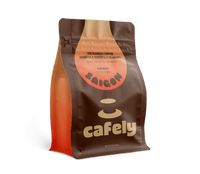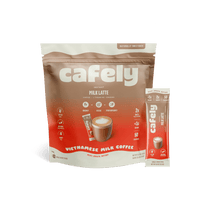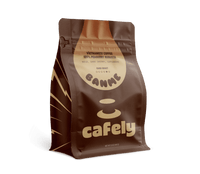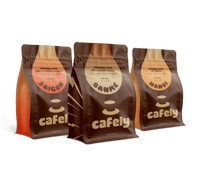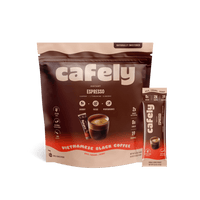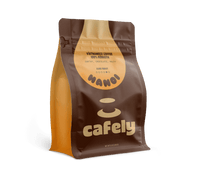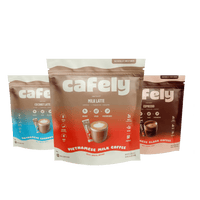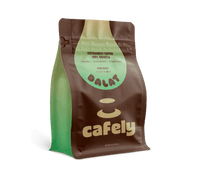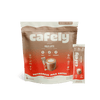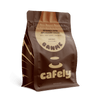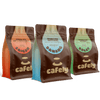A vacuum pot is a unique siphon coffee brewer that uses vapor pressure to push hot water from a lower vessel up into a top vessel that contains ground coffee. The grounds soak, and the finished, filtered brew draws back down into the bottom vessel.
The vacuum pot produces a full-bodied brew with a tempered acidity. When this brewer is used correctly, the coffee is evenly extracted, super-clean, and complex in flavor. However, it's not the easiest coffee brewer to use, and it takes a certain amount of trial and error to master.
In this brew guide, you'll learn how to brew great-tasting coffee with a vacuum pot, get a few tips on how to perfect the brewing process, and learn the types of beverages you can make with vacuum pot coffee.
Vacuum Pot Brewing Specs:
- Brew Time: 5–10 minutes
- Coffee/Water Ratio: Variable
- Grind: Medium (similar to table salt)
- Water Temperature: 208ºF (98ºC)
- Recommended Coffee: DaLat (100% arabica)
Vacuum Pot Brewing Summary
- Boil a kettle of water.
- Measure and grind the coffee.
- Cock the filter in the funnel.
- Fill the bottom chamber to the fill line with hot water and place the top chamber loosely on top.
- Turn the gas burner to high heat and place it underneath the bottom chamber.
- Once the water is boiling, seal the top chamber.
- Lower the heat and add the coffee.
- Turn off the heat and wait for the brew to draw down.
- Remove the top chamber and serve the finished brew.
What You Need to Brew Coffee With a Vacuum Pot

The vacuum pot is not a brewer made for convenience. Although you only need coffee and water to brew coffee in this device, you'll need several pieces of specialist equipment.
Here's what you need to brew coffee with a vacuum pot:
Tools Needed
- Vacuum Pot — These brewers come in various shapes and sizes, but they all feature a similar design.
- Gas Burner — Some vacuum pots come with a gas or alcohol burner, and some do not. Gas burners are more efficient than alcohol burners and tend to produce a more even extraction.
- Metal or Cloth Filter — Most vacuum pots have a metal or cloth mesh filter. These need replacing semi-regularly. If you've purchased a new brewer, it should come with a filter attached, but it may need installing, depending on the brand.
- Weighing Scale — A weighing scale is necessary for accurately measuring the coffee.
- Burr Grinder — A burr grinder is recommended to produce the most consistent grind. Freshly ground whole-bean coffee produces the best brew.
- Kettle — A kettle isn't necessary, but starting with hot water speeds up the brewing process.
- Timer — If you want to produce the perfect brew, you should time each step to the second using a timer — the one on your phone is good enough.
- Coffee Mug — Use your favorite coffee mug to serve the finished brew.
Ingredients
- High-Quality Coffee — Opt for a high-quality whole-bean coffee. If you don't have a grinder, make sure to select a fresh pre-ground coffee from a reputable brand.
- Water — Fresh, filtered water produces the cleanest brew and keeps your vacuum pot in good condition.
Coffee Recommendations
We recommend using 100% arabica coffee, such as Cafely's DaLat for the vacuum pot. The smooth, bold, sweet flavors and subtle undertones of arabica make it the perfect bean for use in this sophisticated brewer.
If you want to produce the best brew in terms of body and flavor, opt for whole-bean coffee. Grinding coffee fresh just before brewing results in a much more complex, charismatic cup than using pre-ground coffee.
If you must use pre-ground coffee, make sure to purchase a high-quality arabica that has been recently processed and ground.
Step-by-Step Brewing Instructions: The Vacuum Pot
The vacuum pot takes a bit of time to understand. Although the concept of this brewer is relatively simple, mastering the technique to make high-quality brews takes time. Don't be disheartened if you don't produce the perfect cup of coffee the first time.
With that said, here's how to use a vacuum pot, step by step:
1. Boil a Kettle of Water
First, boil a kettle of fresh, filtered water. You can add cold water to the vacuum pot, but it's much more efficient to use pre-heated water.
2. Measure and Grind Your Coffee
Measure and grind your coffee to a medium grind size (around the same consistency as table salt). A burr grinder produces the most consistent grind. Blade grinders work too but the inconsistent grind size can negatively impact extraction.
Most vacuum pots require 40 grams of coffee (around 6 tablespoons), but check the requirements for your specific pot before grinding.
3. Prepare the Filter
“Cock” the filter on the top chamber of your vacuum pot. To do this, pull the chain down until the filter sinks into the funnel. Clip the catch on the edge of the funnel's neck to secure it.
4. Add the Water
Add your pre-heated water to the bottom chamber of the vacuum pot. Most pots have a fill line. If your brewer doesn't have this, refer to the manufacturer's manual — it's essential that the correct amount of water is used to ensure the vacuum works correctly during extraction.
5. Apply Heat With the Burner
Place your burner underneath the bottom chamber of the vacuum pot. Make sure the bottom chamber is completely dry before lighting the burner — moisture on the outside can cause the glass to crack when heated.
Turn the burner on and ignite the gas. Open the valve fully to switch it to “high heat.”
Loosely place the funnel of the top chamber inside the bottom, but don't seal the air gap just yet.
6. Secure the Top Chamber
Once the water starts to boil rapidly, secure the top chamber making sure there's an airtight seal between the funnel and neck of the bottom chamber.
7. Add the Coffee
As the water boils, it will rise up through the funnel into the top chamber.
Take a spoon and stir the water quickly to create a whirlpool. Tip your ground coffee into the whirlpool of water, then let it settle.
As soon as you add the coffee, start a timer on your phone (counting upward from zero).
8. Turn Down the Heat (Begin the Extraction)
Turn your burner down to around half (medium heat). Stir the coffee and water.
Wait for 40 seconds, and gently stir it again — fold the grounds into the water during the stage to make sure everything is saturated.
9. Draw the Coffee (Turn Off the Heat)
When your timer hits one minute and 30 seconds, turn off the heat completely.
Wait for the brew to draw down into the bottom chamber — this usually takes around three minutes, but it could be longer or shorter depending on the vacuum pot you own.
10. Serve and Enjoy
Remove the top chamber carefully and set it aside.
Pour the finished brew in the bottom chamber into your coffee mug and enjoy.
Tips for Brewing Coffee With a Vacuum Pot

Mastering the vacuum pot takes time and patience. Paying close attention to every step in the brewing process will help you understand when and where you're going wrong if you're producing sub-par coffee.
Here are a few tips to help you on your vacuum pot journey:
1. Use Freshly Ground Coffee
Although this was mentioned earlier, the importance of freshly grinding your coffee before brewing should be stressed. If you want to brew the best possible cup of coffee using a vacuum pot (or any other brewer, for that matter) you should invest in a good burr grinder.
Although high-quality pre-ground coffee can make a wonderful brew, it's nothing compared to a cup made with coffee you've ground yourself.
2. Control the Water Temperature
It's best to preheat your water before adding it to the bottom chamber of your vacuum pot. This cuts down the heating time tremendously. However, you'll still need to heat the water using the burner before you seal the top chamber.
Make sure the water is at a rolling boil before attaching the top chamber. Sealing the top chamber before the water has fully heated can result in an uneven extraction.
It's always best to be patient with the heating process rather than rush it and risk under-extraction, an uneven brew, and an underwhelming coffee.
3. Monitor the Brew Time Closely
Make sure to keep the water in the top chamber with the coffee for at least one to two minutes (ideally 1.5 exactly).
If you switch the heat off too quickly, you'll under-extract the coffee, which will lead to a watery, weak brew. If you leave the heat on for too long, you'll over-extract the coffee, leading to an overly dark, bitter brew.
Be strict when monitoring the brew time. Turn off the heat exactly one minute and 30 seconds after you add the coffee — this should ensure the perfect extraction. With that said, you may need to adjust the time to suit your brewer and the type of coffee you use.
If your coffee tastes too bitter, turn the heat off sooner next time. If it’s not strong enough, leave the heat on for a little longer.
4. Clean and Maintain Your Vacuum Pot
Clean your vacuum pot after each use with warm water and a mild detergent. Pay attention to the filter and funnel — these areas attract coffee residue that can build up over time. An unclean vacuum pot can taint the taste of the brew and hinder the extraction process.
These brewers can be a pain to clean. The bulbous shape of the bottom chamber and the unusual funnel on the top chamber can be hard to get into. It's wise to buy a few different sponges and bottle cleaners to clean the hard-to-reach areas on your brewer.
You should also check the filter mesh regularly. This won't need replacing all the time but after several brewing cycles, they can become clogged, frayed, and even rusty (if you have a metal filter). Replace the filter mesh if it looks worn, clogged, or worse for wear.
What Beverages Can You Make With a Vacuum Pot?
The vacuum pot can make delicious, complex coffee that's a delight to drink black. However, you can use this brew to make several other enjoyable beverages.
Here are three different beverages you can make with a vacuum pot:
1. Iced Coffee
You can make delicious iced coffee using a brew made with a vacuum pot.
Making iced coffee with a vacuum pot is a simple process. Here's how to do it:
- Brew the Coffee — Brew a strong, concentrated coffee with the vacuum pot. Adjust the coffee-to-water ratio by around 50% and brew the coffee according to the guide above. We recommend a blend or 100% robusta coffee for iced coffee.
- Cool the Coffee — Once your coffee has been brewed, you'll need to cool it. You can do this by tipping the brew back and forth between two cups or adding a single ice cube.
- Prepare Your Glass — Fill a glass with ice and add sugar or syrup if you wish to make a sweet iced coffee.
- Add the Coffee — Pour your concentrated coffee into the glass. Stir rapidly to incorporate the sugar or syrup (if using).
- Add the Milk — Fill the rest of the glass with whole cow's milk or a dairy-free alternative.
- Serve and Enjoy — If you want a marbled effect, serve the coffee without stirring. If you want an evenly distributed iced coffee, stir the beverage to combine the milk and coffee. Top with whipped cream if desired, and enjoy while the brew is ice-cold.
2. Mocha Coffee
Mocha coffee combines the dark, sweet notes of chocolate with the bold, bitter notes of coffee. The mocha is a creamy, indulgent coffee that can be made using a vacuum pot.
Here's how to make mocha coffee with a vacuum pot:
- Brew the Coffee — Brew a serving of arabica coffee using your vacuum pot. Follow the brew guide above to achieve this.
- Prepare the Chocolate — Using a sharp knife, finely chop a serving of dark chocolate. Add the shavings to a bowl followed by a tablespoon or two of freshly boiled water. Stir the mixture together until a thick chocolate syrup forms.
- Heat the Milk — In a pan, add half a cup of whole milk or a dairy-free alternative. Heat the milk over low to medium heat until warm but not boiling.
- Add the Chocolate — Add the chocolate syrup to the milk and stir to thoroughly combine. Once combined, you'll be left with rich, warm chocolate milk.
- Assemble the Brew — In a coffee mug or heat-proof glass, add the coffee, followed by the chocolate milk. Stir to combine.
- Sweeten (Optional) — Add a teaspoon of sugar or syrup if you wish to sweeten your mocha coffee.
- Garnish and Serve — Add a generous dollop of whipped cream and sprinkle a dusting of chocolate over the top (optional). Serve the brew and enjoy while warm.
3. Vietnamese Coffee
Vietnamese coffee is a rich robusta brew that's mixed with sweetened condensed milk. Vietnamese coffee combines the bold, bitter flavors of robusta with the sweet creaminess of condensed milk to create a perfectly balanced brew.
Traditionally, Vietnamese coffee is made with a phin filter but you can produce a similar brew with the vacuum pot.
Here's how to make Vietnamese coffee with a vacuum pot:
- Brew the Coffee — Brew a short cup of coffee by reducing the water content by around 25%. Use a 100% robusta such as authentic HaNoi blend or strong BanMe Coffee.
- Assemble the Brew — Pour the coffee into a mug or heat-proof glass. Then, add two tablespoons of sweetened condensed milk and stir. Enjoy while warm.
- Bonus (Iced Coffee) — Vietnamese coffee is often served cold. To make Vietnamese iced coffee, cool the brew before combining it with condensed milk and serve over ice.
Learn more about the history of Vietnamese coffee.
FAQs: The Vacuum Pot
Want to learn more about the vacuum pot and other unique coffee makers?
Check out the answers to the FAQs below:
1. What is a Vacuum Pot Coffee Maker?
A vacuum pot coffee maker — also known as a siphon — is a device that uses vapor pressure and a vacuum to brew coffee. It consists of two vessels — a lower one that holds water and a higher one that colds ground coffee. When heated, the water from the lower chamber rises into the upper chamber where it mixes with the coffee.
Once the heat is removed, the brew passes down through a filter where it's collected in the bottom chamber.
2. How Much Caffeine in a Cup of Coffee Made With a Vacuum Pot?

The caffeine content in a cup of coffee made with a vacuum pot typically ranges from 70 to 135 mg. However, the type of coffee, coffee-to-water ratio, grind size, and brew time can all affect the strength of the resulting brew. It's also worth noting that other ingredients — like syrups or chocolate — can add to your caffeine intake. For reference, the caffeine amount in chocolate can vary depending on the cocoa content.
3. What’s the Best Coffee for a Vacuum Pot Coffee Maker?
The best coffee for a vacuum pot coffee maker is arabica. The subtle, delicate flavor profile shines when brewed with this device. High-quality whole-bean arabica that's freshly ground before brewing produces the most charismatic cup of coffee.
4. Can You Add Milk to Vacuum Pot Coffee?
Yes. Although high-quality coffee brewed with a vacuum pot tastes great black, you can add a dash of milk to enhance the creaminess of the brew. Whole cow’s milk works well. Vegan alternatives such as oat milk, coconut milk, and almond milk can also be used to make vacuum pot coffee more creamy.
5. Is a Drip Coffee Maker the Same as a Vacuum Pot?
No. A drip coffee maker is an electric machine that automatically heats and drips water over ground coffee. As the water passes through the coffee and a paper filter, a clean brew is collected in a carafe below. The vacuum pot is a manual brewer that relies on vapor pressure and a vacuum to extract the flavors from ground coffee.
6. What is a Pour-Over Coffee Brewer?
A pour-over coffee brewer can be thought of as a “manual drip coffee maker.” Pour-over brewers work by manually pouring hot water over ground coffee that's inside a filter-lined brew chamber. The water passes through the filter into a coffee mug or carafe below. Popular pour-over coffee brewers include the Hario V60, Chemex brewer, Kalita Wave, and Clever Dripper.
7. Can You Make Iced Coffee With a Vacuum Pot?
Yes. Making iced coffee with a vacuum pot is simple. Brew a pot of coffee as usual, but increase the coffee-to-water ratio to create a concentrated coffee. Cool the coffee, pour it over ice, and combine it with milk and sugar to taste.
8. What’s the Difference Between Arabica and Robusta?
Arabica and robusta are two different types of coffee beans from the species Coffea arabica and Coffea robusta. The more popular Arabica coffee beans produce a smooth, bold, naturally sweet cup of coffee with a mild caffeine content. Robusta beans produce a bold, dark, slightly bitter brew with a strong caffeine content. Robusta is around twice as strong as arabica; it also contains less natural sugars, giving it a “robust,” dark flavor.
9. Can You Make Espresso Without an Espresso Machine?
You can't make a true espresso without an espresso machine. However, several different brewers can achieve a similar shot, and most of them are cheaper to buy than an espresso maker. The moka pot, Aeropress brewer, and Rok espresso makers are the best alternative brewers for making espresso-like coffee. You can also opt for an instant espresso coffee — these make a strong, dark shot of coffee in seconds just by adding water.
10. Can You Make a Latte Without an Espresso Maker?
You can't make a true latte without an espresso maker. You need the ability to brew a strong, bold espresso and steam milk to a light, velvety texture. However, you can make a similar coffee by brewing a concentrated shot using a brewer of your choice and combining it with frothed milk. To froth milk, heat high-fat milk in a pan and whisk thoroughly with a fine whisk or milk frother until a light foam is produced.
